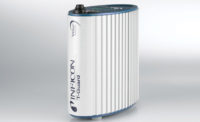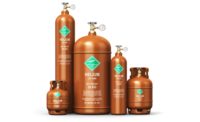Manufacturers in the automotive, refrigeration and air-conditioning industries today rely on helium- and hydrogen-based leak detection systems to assure the overall quality of their heat exchangers.
In the automotive sector, strict new governmental emissions and fuel-economy requirements are driving the need for major HVAC and powertrain improvements which in turn will require stricter leak testing and additional high-quality heat exchangers. The introduction of exhaust gas recirculation, for example, requires an additional EGR cooler. The increased use of turbo chargers to improve gas mileage also calls for more charge-air intercoolers.
TECH TIPSThirty years ago, most suppliers relied on relatively simple water-bath methods to identify leaks from bubbles generated in the bath. Today the majority of all heat exchangers are tested for leaks in either a vacuum or accumulation chamber using helium or hydrogen tracer-gas solutions. Original equipment auto manufacturers annually conduct more than 800 million leak tests on critical heat exchangers. |
For air conditioners, the auto industry currently is switching from R134a (used as refrigerant in car air conditioners for the last decade) to the more environmentally friendly but flammable HFO-1234yf. Refrigerant flammability drives a need to further test all mobile AC components (in this case, the evaporator and the condenser) for lower leak rates. More complex designs introduced to efficiently use limited under-hood space also limit the use of traditional testing methods such as water-bath testing.
In the more general HVAC market a growing need for more efficient heat exchangers also is being fueled by higher energy costs and rising demand for consumer products outside of Europe and North America. A switch from copper to lighter aluminum components that are easier to weld also leads to a potential for additional leaks. In the refrigerator and air-conditioning (RAC) market, guidelines for refrigerants are affecting supply-chain leak-detection requirements due to changes in the physical characteristics of the new refrigerants.
Auto suppliers last year produced nearly 400 million heat exchangers globally while combined production of heat exchangers for the air-conditioning and refrigeration industries totaled more than 420 million units. All three sectors expect demand for heat exchangers to grow at an annual rate of four to five percent or more over the next five years.
Thirty years ago, most suppliers relied on relatively simple water-bath methods to identify leaks from bubbles generated in the bath, according to Thomas Parker, North American automotive sales manager at INFICON. Today, the majority of all heat exchangers are tested for leaks in either a vacuum or accumulation chamber using helium or hydrogen tracer-gas solutions.
Original equipment auto manufacturers annually conduct more than 800 million leak tests on critical heat exchangers ranging from radiators, engine oil coolers and EGR coolers to HVAC components such as evaporators and condensers. Costs are significant as well. The average online vacuum leak-detection system costs from $200,000 up to $500,000 while accumulation systems cost from $50,000 up to $150,000. Systems used off line to check repair work can range in cost between $20,000 and $30,000 each.
Parker notes that less expensive pressure-decay tests are adversely affected by variations in temperature and aren’t suitable for testing heat exchangers which by design are subject to rapid changes in temperature. During pressure-decay tests increases in temperature tend to hide leaks, while temperature drops may create “phantom” leaks.
Tracer-gas leak-detection systems on the other hand are unaffected by temperature change and are ideally suited for testing heat exchangers. For small- to medium-sized parts with potential oil or water leaks, tests with helium or hydrogen tracer gas in an accumulation chamber are the most cost-effective. For larger parts that need to be tested for refrigerant leaks, Parker recommends vacuum-chamber leak testing with helium.
Parts tested in an accumulation chamber are filled under pressure with helium or hydrogen so that the test gas will escape through any leaks into the chamber. Fans ensure even distribution of the test gas in the chamber in order to guarantee precise measurements. A helium or hydrogen leak detection sensor is then used to determine the amount of gas in the chamber and calculate the size of the leak.
Larger components, especially those being tested for refrigerant leaks, are placed in a sealed vacuum chamber. Large pumps simultaneously create a vacuum within the component and the chamber and the component is then back-filled with helium tracer gas that can migrate into the vacuum chamber if there is a leak. A highly sensitive helium leak detector that is valved into the system can then be used to detect any helium atoms that escape from the component. Smart system design can include helium reclaim of the use of diluted helium down to five percent helium mixed in nitrogen for more economical testing.
If a leak is detected by either method, the location of the leak must be found to facilitate repairs. Depending on leak-rate requirements, the heat exchanger will be filled with a forming gas (usually a mixture made up of five percent hydrogen and 95 percent nitrogen) or helium. A leak detector designed with a hand-held “sniffer” then is used to locate leaks by passing the sniffer tip along welds and other potential leak locations. After repairs are made, they can be checked using the same method.
It is estimated that the global market for RAC heat exchangers will reach more than $18 billion by 2020, up from about $13 billion last year.






